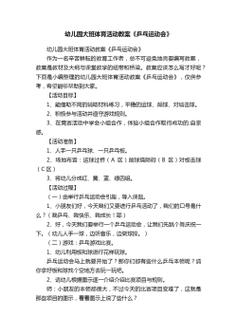乒乓球优质课教案
Title: Designing an Effective Table Tennis Lesson Plan

Designing an Effective Table Tennis Lesson Plan
Table tennis, also known as ping pong, is a fastpaced and engaging sport enjoyed by millions around the world. Whether you're a seasoned coach or a beginner looking to organize your first lesson, a welldesigned lesson plan is essential for effective teaching and learning. In this guide, we'll outline the key components of a comprehensive table tennis lesson plan.
Start the lesson by introducing yourself and explaining the objectives for the session. Begin with a brief warmup to prepare the players physically and mentally for the activities ahead. This could include light jogging, dynamic stretching, and shadow strokes to loosen up the muscles and improve focus.
Next, focus on the fundamental techniques of grip and stance. Demonstrate the correct grip for both the forehand and backhand strokes, emphasizing the importance of a relaxed but firm grip. Teach the basic stance, ensuring players maintain a balanced and athletic position throughout the lesson.
Divide this section into segments focusing on different strokes and techniques:
- Forehand Stroke: Break down the forehand stroke into its components – preparation, contact, and followthrough. Use drills and exercises to reinforce proper technique and encourage consistency.
- Backhand Stroke: Similarly, teach the basic backhand stroke, paying attention to grip adjustment and body positioning. Provide opportunities for players to practice both the forehand and backhand strokes in controlled settings.
- Footwork: Introduce basic footwork patterns such as sidetoside movement and forward/backward positioning. Emphasize the importance of quick, efficient footwork in table tennis.
Allocate ample time for players to practice the skills they've learned through drills and practice games. Consider incorporating the following activities:
- MultiBall Drill: Use a multiball feeding machine or recruit helpers to feed balls to players, allowing them to practice strokes and footwork in rapid succession.
- Shadow Play: Have players simulate game situations by practicing strokes and footwork without a ball. This helps reinforce muscle memory and decisionmaking skills.
- Mini Matches: Divide players into pairs or small groups for mini matches, where they can apply their newly acquired skills in a gamelike setting.
Finally, conclude the lesson with a brief cooldown period consisting of light stretching and relaxation exercises. Encourage players to reflect on their performance during the session, identifying areas of improvement and setting goals for future practice.
Assign homework tasks, such as practicing specific strokes or footwork drills at home, to reinforce learning outside of the lesson. Provide guidance on resources or online tutorials that players can utilize for further skill development. Discuss plans for future lessons and encourage players to stay motivated and committed to their training.
By following these steps and tailoring the lesson plan to the skill level and needs of your players, you can create an engaging and productive table tennis lesson that fosters skill development and enjoyment of the sport.
